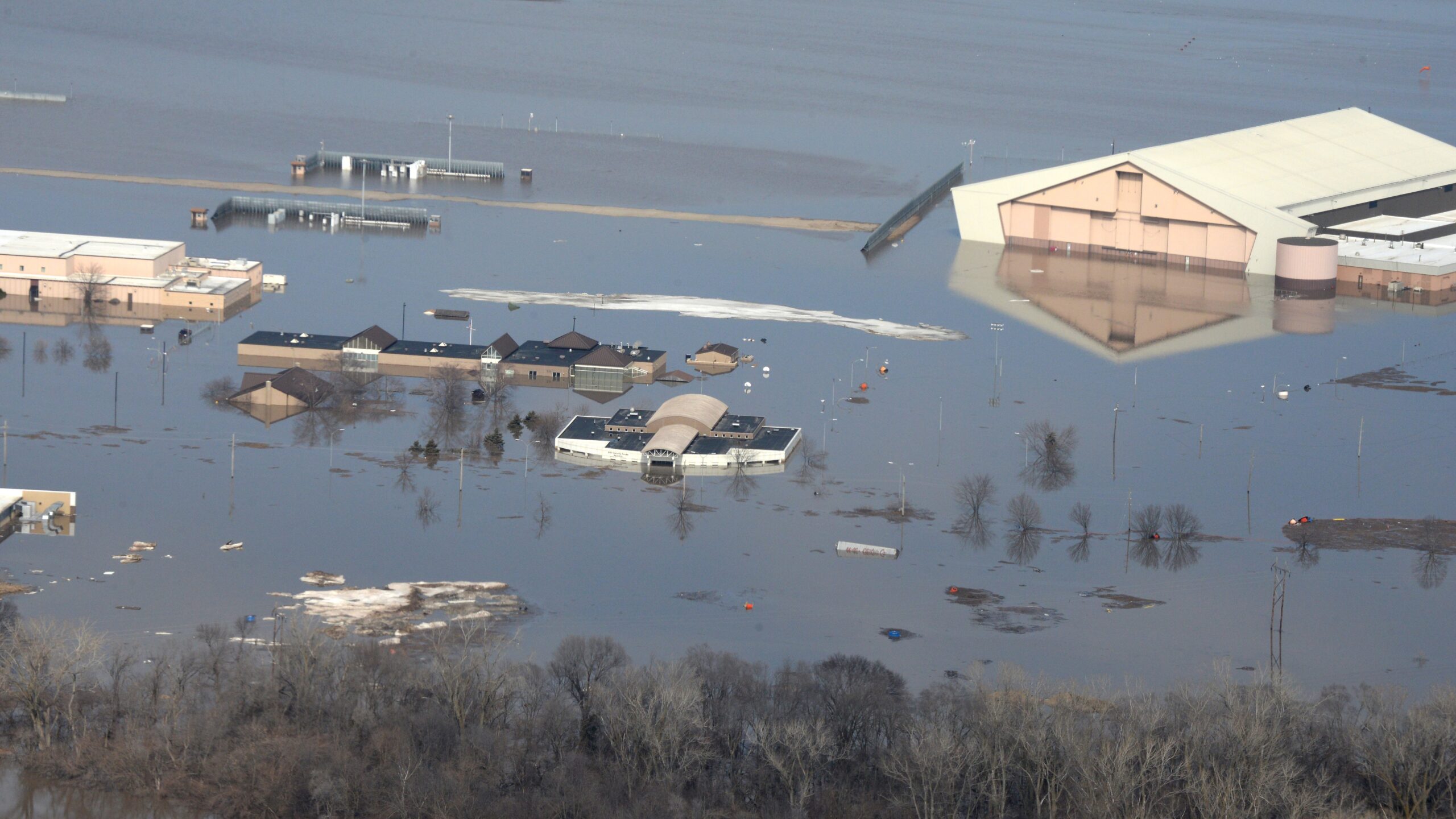
Offutt Air Force Base suffered major flooding in 2019. Climate change concerns about bases are front of mind for Pentagon planners. (US Army/ Rachelle Morris)
As soon as he took office, President Joe Biden made it clear that combating climate change would be a priority throughout his administration, including at the Pentagon. It’s been a message amplified by top defense officials, with pledges to have specific climate change-related financial call outs in the next budget. But as Hallie Coyne of AEI writes, the Pentagon needs to change how it tracks this money to provide anything resembling accuracy.
Deputy Secretary of Defense Kathleen Hicks is focused on reporting climate change spending for the Defense Department in the Pentagon’s budget request for fiscal year 2023. Speaking at a Defense News conference in early September, Hicks promised that spending for climate change will be “very clearly tagged out in the FY23 budget displays.”
A month later, the Department of Defense released its landmark Climate Adaptation Plan [PDF], which on paper seems like an easy fit into Hicks’ plan for having a designated pot of money for the issue. But officials quickly acknowledged it would be hard to tie new budget decisions directly to the strategy, since most additional funding would be added to existing investment programs, underlining a reality: while the tagging exercise Hicks is promising is undeniably important, it needs to come with heavy, heavy caveats. And as a result, the department needs a refined approach if it wants to make genuine progress on this topic.
Hicks’ pledge is not the first attempt to create a specific pot of money for climate change. In fact, the recent FY22 request included a $617 million ask [PDF] for new funding dedicated to “preparing for, adapting to and mitigating climate change.” The total combines several different efforts and as other analysts point out, “There is no ‘climate change’ line item in the budget.” The $617 million is just a selection of new dollars for a few key climate-related programs.
Further, $617 million is by no means a full representation of how the Pentagon is already addressing the risks posed by climate change for its facilities and installations, setting requirements for equipment to operate in more extreme environments, and investing in renewable energy sources. After all, climate change was on the radar for the military and intelligence communities dating back to at least the 1990s; while politics has slowed or sped up efforts throughout the years, it never truly stopped them.
RELATED: Intel Assessment: ‘High’ Chance Of International Conflict Over Water By 2040
In fact, those political headwinds and partisan debates likely did the opposite and led relevant programs to be hidden inside other efforts. Defense planners are masters of hiding pots of money in the budget, and digging those dollars up is difficult by design. As a result, the Pentagon’s preliminary $617 million climate change fund proved incomplete at best, and potentially deceptive at worst.
Let’s use the Army’s “wish list” for this year as a case study.
To protect funding for missiles, vehicles, helicopters, and more this year, the Army made cuts to lower-priority programs in its FY22 budget request. However, the service made liberal use of congressionally required “wish lists,” sending unfunded priorities lists outlining where they would spend additional dollars, should Congress appropriate funding above the budget request. Army programs that logically connect with large-scale Defense Department efforts to address climate change related challenges surprisingly wound up on the service’s wish list this year, instead of receiving full funding in the Army’s budget request.
For example, as part of its unfunded list, the Army asked Congress to provide $5.6 million for initial research on the currently unfunded Electric Light Attack Reconnaissance Vehicle (eLRV) program, a key part of the service’s efforts to reduce its reliance on fossil fuels by adopting more electronic vehicle technology. The program was not funded in the Army’s base budget request. Meanwhile, as part of its climate change funding, the Pentagon asked for $153 million [PDF] for “leveraging DoD buying power to improve the energy efficiency of operational platforms…[and] modernizing the non-tactical fleet through electrification.”
The Army also asked for a range of infrastructure modernization efforts, a funding category that will likely be among the first to address the most obvious impacts [PDF] of climate change as temperatures climb, weather becomes more volatile, and sea levels rise at unpredictable rates. These included $1 million for an Army Climate Assessment Tool (ACAT) to support planning for “desertification at Army installations in the U.S. West,” $4 million to support climate resilience at Fort Huachuca, and $20 million for power infrastructure upgrades required to support the Army’s electric vehicle fleet.
But again, the Army must rely on Congress securing more money for its infrastructure improvement efforts while the requested $617 million climate change budget add includes $263 million [PDF] dedicated to “strengthening installation mission resilience,” specifically in instances of public infrastructure disruptions resulting from severe weather or other events.
RELATED: Biden Orders Pentagon To Include Climate Change In New Strategy & War Games
It’s hard to follow, right? Put plainly: the Pentagon requested $153 million for the same kind of technology development the Army is seeking, but the Army’s program was not listed as part of the $617 million climate bucket. The Pentagon requested $263 million for (broadly) the same kind of installation modernization the Army is seeking, but the Army’s programs were not listed as part of the $617 million climate change bucket. Should Congress fund those efforts, it won’t be tallied as climate change funds — even though they are clearly applicable.
So that is the challenge before the Defense Department. How to proceed?
The Pentagon should start by explaining how it chose which programs merit a climate change “tag” in its budget request for next year, and release documentation to this end. Congress should subsequently prepare to scrutinize what programs make it on the climate change “list” and what gets left off.
In addition, the Pentagon should provide a full five-year spending plan for each program tagged for climate change next year to establish a framework for analysts to track how climate change features in the defense budget throughout the duration of the Biden administration. Further, the Defense Department must walk a careful line between ensuring that relevant programs receive the funding they need and resisting the urge to expansively define climate change spending to protect loosely related lines of effort.
Fundamentally, if the Pentagon seeks to demonstrate that climate change-related funding will not be in competition with other programs that warfighters need, then the Defense Department must be transparent about where dollars are coming from and going to. Robbing Peter to pay Paul is pointless, and leaders must get on the same page sooner rather than later to drive real change.
Hallie Coyne is a research associate at the American Enterprise Institute, and studied defense policy at the King’s College London Department of War Studies and Boston University.
Air Force nears Wedgetail deal with Boeing after jostle over costs
“We think we can substantially improve over what Boeing offered us. I would say we will not meet in the middle,” said Air Force acquisition czar Andrew Hunter.


























